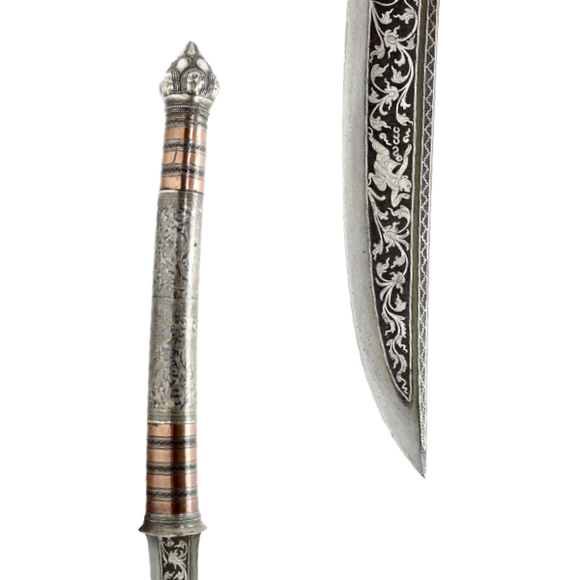Language: Burmese
Source: Period accounts
Description
Mindan is a village in Yamethin district, just south of Mandalay. It was known for its industry of making ornate scissors, tweezers, betel cutters and most notably fine dha with fine silver overlay.
The village was subject of Bell's monograph on Iron and Steel production in Burma:
"Another artistic development has its home in Mindan Village, Yamethin District, where every household depends more or less on its smithy, though there are only a few professors of the particular art to be described, which consists of an inlay of silver wire upon an iron surface. The usual articles produced are ornamental dalwes or da-hmyaungs, scissors, ...
This industry is said to have had its origin five generations before Saya whose son Saya Pyo, the chief local artist, turned out the articles shown in the illustrations. The originator's name is forgotten, but the art is traditional, from father to son, each improving on his ancestors, as Saya Lan himself said:
"I was better than my father, and now my son, Maung Pyo, is better than I ever was." 1
-E.N. Bell, Rangoon, 1907.

A number of typical Mindan style dha.
Mandarin Mansion stock of 2019.

A pair of scissors by Saya Pyo of Mindan Village.
In historical sources
"The inlaid dha and dagger blades of Mindan near Yamèthin are well-known. The dhas are inlaid in gold, silver and brass."2
-Gazetteer of Upper Burma and the Shan states. 1901.
"Of the 26,221 workers and dependents shown in the census returns under the head of workers in iron and hardware, few can have been capable of executing anything more than the coarsest blacksmith's work. An exception must, however, be made in favour of the forgers of the inlaid knife-blades produced in Yamethin District, some of whose work is really meritorious." 3
-Imperial Gazzetteer of India, Provincial Series, Burma Vol 1. 1908.
When he wrote his monograph in 1907, the tradition was said to have started five generations before Saya. Assuming some 30 years for each generation, this puts the origin of the work in about the middle of the 18th century.
Origin of the work
The type of overlay resembles the koftgari done in India, with the difference than on Indian work usually only the place where the design is placed will be crosshatched. On these dha, a larger surface is crosshatched and the design "drawn" with a piece of metal wire that is carefully hammered in. This method was also common on Ottoman pieces, where gold wire was used to, among others, create fine islamic calligraphy on cartouches on blades.
This seems a long shot, but especially Burma's coast has a very long history of Islamic settlers. By the early 18th century, many port authorities were of Armenian descent.4
Notes
1. E.N. Bell I.C.S.; A Monograph on Iron and Steel Work in Burma. Rangoon, Superintendent, Government Printing Burma, 1907.
2.James George Scott, John Percy Hardiman; Gazetteer of Upper Burma and the Shan states, Part II, Vol III, 1901. Page 386.
3. Imperial Gazetteer of India, Provincial Series, Burma Vol 1. The Province; Mountains, Rivers, tribes, etc.; And the Arakan, Pegu, Irrawaddy, and Tenasserim Divisions. Superintendent of Government Printing, Calcutta. 1908. Page 79.
4. Moshe Yegar; The Muslims of Burma.




